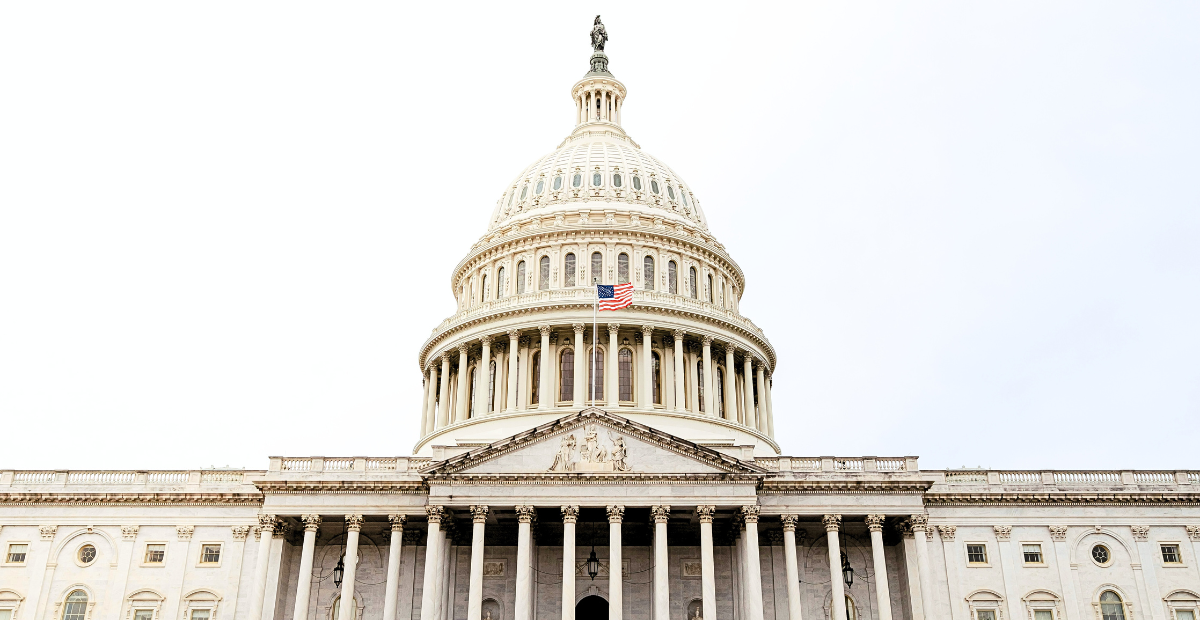LDN. Senate Reaches Deal In Longest Government Shutdown; Sends It Back To The House.LDN

The government shutdown that began on October 1 may have an end in sight. This was the first government shutdown in six years, and it is the longest in American history. (Photo credit: Ioana Ye / Unsplash)
The Government Shutdown Started On Oct. 1
After 41 days, the government shutdown that began on Oct. 1 is continuing, but with an end in sight.
Voting 60-40 on three key bills on November 10, the Senate approved a continuing resolution to keep the government running through January 30, 2026.
Now, it must head back to the House of Representatives for approval.
This accomplishment was made despite President Donald Trump‘s continued calls for Republicans to use the “nuclear option” to do away with the filibuster, allowing for a simple majority of 51, rather than the required 60 votes to approve a funding measure.
Aligning themselves with Republicans were seven Democrats and one Independent: Sen. John Fetterman, D-PA; Sen. Catherine Cortez Masto, D-NV; Sen. Jacky Rosen, D-NV; Sen. Dick Durbin, D-IL; Sen. Jeanne Shaheen, D-NH; Sen. Maggie Hassan, D-NH; Sen. Tim Kaine, D-VA; and Sen. Angus King, I-ME.
Notably, Sen. Rand Paul, R-KY, was the only Republican holdout.
Moving Toward The End Of The Shutdown
The Senate’s approval of this trio of funding bill allows Republicans and Democrats to have the time to deliberate over the changes to the federal government’s budget that they would like to see.
Dubbed the “Democrat Shutdown” by the White House, many Democrat senators had been opposed to any resolution that did not expand subsidies for those enrolled in the Affordable Care Act, or Obamacare.
On the 40th day of the shutdown, Nov. 9, Senate Majority Leader John Thune, R-SD, and fellow Republicans proposed a new offer regarding an end to the shutdown.
Instead of simply proposing to continue funding the government with the previous budget to allow for more debate, as Republicans had pushed for in 14 failed attempts to reopen the government, Republicans in the Senate chose to sweeten the deal on day 40.
Their proposal is for a “minibus,” which includes the aforementioned clean, stopgap continuing resolution to fund the government, as well as funding bills which will ensure a variety of federal programs remain open regardless of a future government shutdown for the next year.
Among those programs are benefits through SNAP, or the Supplemental Nutrition Assistance Program, which is included with funding for the U.S. Department of Agriculture. Further, funding for the U.S. Food and Drug Administration and veterans benefits will remain funded for the coming year.
This Republican-backed plan follows a proposal for a compromise that was issued by the Democrats, presented on the floor of the Senate on Nov. 7, the 38th day of the shutdown.
“We would like to offer a simple proposal that would reopen the government and extend the [Affordable Care Act] premium tax credits simultaneously, and then have the opportunity to start negotiating longer-term solutions to health care costs,” said Senate Minority Leader Chuck Schumer, D-NY, on the floor of the Senate on Nov. 7.
This compromise was designed by Schumer and the Democrats to meet a standard set by Senate Majority Leader John Thune, R-SD, who has not wished for health care to be the subject of debate during the shutdown.
Describing the compromise as a “reasonable offer,” Schumer and the Democrats’ proposal ultimately never panned out.
Watch Thune’s pitch to Democrats in the Senate, here:

With an end to the government shutdown in sight, active duty military personnel, border patrol, and civilian Department of War employees may no longer have to worry about when they will receive their next paycheck.
Similarly, air traffic control, veterans services, economic data collection, and even national park and monument staffing, could soon have funding fully restored and operational.
Additionally, the 42 million Americans who participate in SNAP, or Supplemental Nutrition Assistance Program, may soon not have to go without their full food benefits.
For the past six weeks, the House of Representatives has not convened, but Speaker Mike Johnson, R-LA, placed all representatives on 36-hour notice to return “immediately” to D.C. to resolve the shutdown.
What Led To The Shutdown?
While the White House called it the “Democrat Shutdown,” Democrats called it the “Trump Shutdown.” Regardless, the shutdown has become the longest in American history, with senators divided over a clean, stopgap continuing resolution.
This continuing resolution, which passed in the House of Representatives on Sept. 19 in a vote of 217-212, would have funded the government through Nov. 21.
During the shutdown, at an Oct. 2 press conference, House Majority Leader Rep. Steve Scalise (R-LA) spoke on the significance of the continuing resolution, saying:
“We know that there is a very straightforward way out of this, and that is for Senate Democrats to join with Senate Republicans and vote for the bill that opens up the government and allows negotiations to continue. Surely, by opening up the government again, it doesn’t resolve all of our differences, but it allows us to negotiate without [Sen.] Chuck Schumer holding the American people hostage.”
Democrats largely held firm in their opposition to the continuing resolution, saying the government’s budget would need to extend expiring subsidies for the Affordable Care Act, also known as Obamacare.
On Oct. 3, House Speaker Mike Johnson pointed to the reason for Republican’s disapproval of extending these subsidies, saying that $192 billion in the Democrat-proposed continuing resolution would go toward healthcare for illegal migrants.
While the opposition to the Republican’s clean stopgap continuing resolution was largely partisan, there were some Republican holdouts, with Sen. Rand Paul (R-KY) being one of the most vocal.
Paul argued that the continuing resolution ran counter to fiscal conservatism, upholding moves that have placed the United States’ debt at over $37 trillion.
“DOGE made real cuts—foreign aid, rescission packages, a leaner federal workforce,” wrote Paul on X, formerly Twitter. “The current [continuing resolution] wipes them all out. Instead of shrinking government, Washington is taking another step backward.”
Watch Paul speak on the shutdown, here:
https://platform.twitter.com/embed/Tweet.html?creatorScreenName=grantvbromley&dnt=false&embedId=twitter-widget-0&features=eyJ0ZndfdGltZWxpbmVfbGlzdCI6eyJidWNrZXQiOltdLCJ2ZXJzaW9uIjpudWxsfSwidGZ3X2ZvbGxvd2VyX2NvdW50X3N1bnNldCI6eyJidWNrZXQiOnRydWUsInZlcnNpb24iOm51bGx9LCJ0ZndfdHdlZXRfZWRpdF9iYWNrZW5kIjp7ImJ1Y2tldCI6Im9uIiwidmVyc2lvbiI6bnVsbH0sInRmd19yZWZzcmNfc2Vzc2lvbiI6eyJidWNrZXQiOiJvbiIsInZlcnNpb24iOm51bGx9LCJ0ZndfZm9zbnJfc29mdF9pbnRlcnZlbnRpb25zX2VuYWJsZWQiOnsiYnVja2V0Ijoib24iLCJ2ZXJzaW9uIjpudWxsfSwidGZ3X21peGVkX21lZGlhXzE1ODk3Ijp7ImJ1Y2tldCI6InRyZWF0bWVudCIsInZlcnNpb24iOm51bGx9LCJ0ZndfZXhwZXJpbWVudHNfY29va2llX2V4cGlyYXRpb24iOnsiYnVja2V0IjoxMjA5NjAwLCJ2ZXJzaW9uIjpudWxsfSwidGZ3X3Nob3dfYmlyZHdhdGNoX3Bpdm90c19lbmFibGVkIjp7ImJ1Y2tldCI6Im9uIiwidmVyc2lvbiI6bnVsbH0sInRmd19kdXBsaWNhdGVfc2NyaWJlc190b19zZXR0aW5ncyI6eyJidWNrZXQiOiJvbiIsInZlcnNpb24iOm51bGx9LCJ0ZndfdXNlX3Byb2ZpbGVfaW1hZ2Vfc2hhcGVfZW5hYmxlZCI6eyJidWNrZXQiOiJvbiIsInZlcnNpb24iOm51bGx9LCJ0ZndfdmlkZW9faGxzX2R5bmFtaWNfbWFuaWZlc3RzXzE1MDgyIjp7ImJ1Y2tldCI6InRydWVfYml0cmF0ZSIsInZlcnNpb24iOm51bGx9LCJ0ZndfbGVnYWN5X3RpbWVsaW5lX3N1bnNldCI6eyJidWNrZXQiOnRydWUsInZlcnNpb24iOm51bGx9LCJ0ZndfdHdlZXRfZWRpdF9mcm9udGVuZCI6eyJidWNrZXQiOiJvbiIsInZlcnNpb24iOm51bGx9fQ%3D%3D&frame=false&hideCard=false&hideThread=false&id=1973502310048530822&lang=en&maxWidth=560px&origin=https%3A%2F%2Fcountryrebel.com%2Fsenate-reaches-deal-in-longest-government-shutdown-sends-it-back-to-the-house%2F&sessionId=33d68f1192f7894c34321253bdc68eb2959eaaf5&theme=light&widgetsVersion=2615f7e52b7e0%3A1702314776716&width=550px
Gradually, the partisan divide began to give, with Sen. John Fetterman, D-PA; Sen. Catherine Cortez Masto, D-NV; and Sen. Angus King, I-ME being among the first to align themselves with a Republican plan.
“I choose country over party,” wrote Fetterman on X on Oct. 22, which is when he chose to support reopening the government at all costs.

